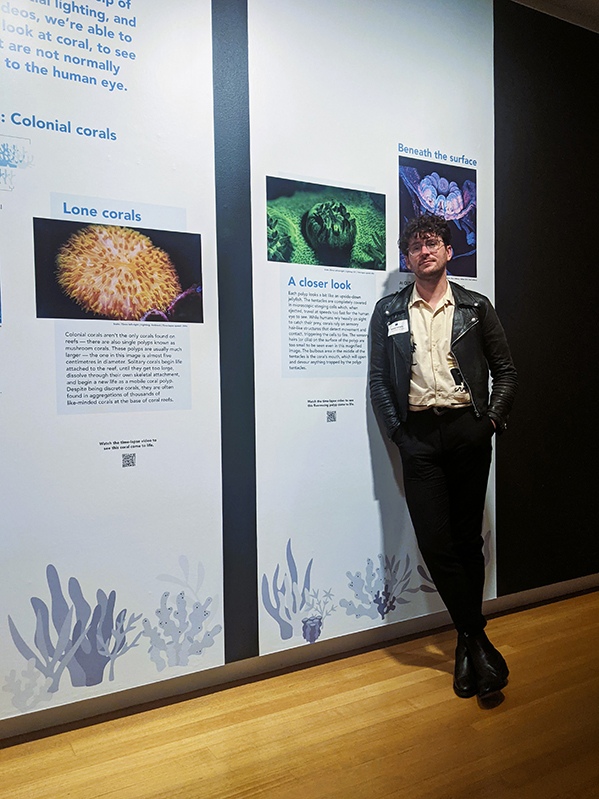
布雷特·刘易斯(Brett Lewis)的珊瑚虫之美,尼康微观世界2022年显微摄影大赛的获胜者之一
布雷特·刘易斯(Brett Lewis)自年轻时就热爱著珊瑚和视觉科学。他致力于记录和研究澳大利亚海岸周围的珊瑚群。在拍摄珊瑚组织和细胞的图像时,他利用先进的显微技术来进一步了解生物及其行为。由于布雷特拍摄的珊瑚图像有著清晰的分辨率而备受赞誉。他的图像、研究和视频被用于“珊瑚礁救援”纪录片中,该纪录片“揭示了‘超级珊瑚’背后的开创性科学,以及拯救地球濒危珊瑚礁的激进新计划”。此纪录片后来在Netflix上获奖。事实上,布雷特的作品出现在10多部纪录片中和全球30多个博物馆和海洋教育中心。
最近,他的单个珊瑚虫的自发荧光图像赢得了著名的尼康微观世界2022年显微摄影大赛的前20名。在接下来的采访中,你将更进一步地了解布雷特本人和他对珊瑚的热爱。
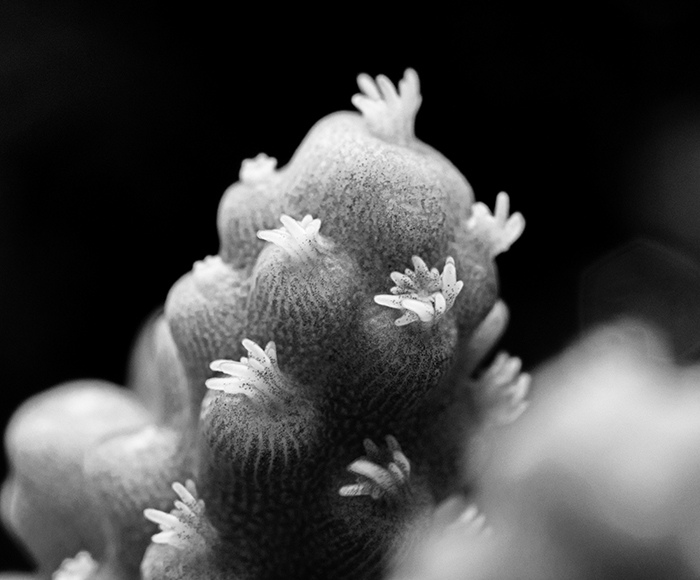
问:祝贺你的珊瑚虫图像荣获尼康微观世界2022年显微摄影大赛的前20名。请告诉我们你成为优秀显微摄影师的背景和培训。
答:感谢你对我的称赞,谢谢。
就如生活中的一切一样,成为一名显微镜学家,尤其是成为珊瑚成像摄影师并不是我原来生涯计划的一部分。其实,我想成为电影《侏罗纪公园》中的艾伦·格兰特博士,哈哈。
在我20几岁时,我开始在澳大利亚旅行并在大堡礁度过一段时间,然后在热带岛屿上工作并花大量时间在水下探索珊瑚礁。在这段期间情况发生了变化,我爱上了珊瑚礁的美丽、色彩和生命。在这里,我开始学习摄影,捕捉珊瑚礁的非凡环境。我最终在白日梦岛(Daydream Island)的一个大型户外水族馆工作,在那里我带领游客参观、教育他们,同时我也照顾鲨鱼和黄貂鱼等海底生物。
正是在这里,我决定要成为一名海洋科学家。
起初,我想继续研究鲨鱼和黄貂鱼,但是在我的大学里,这方面的研究并不多。所以最终我选择了更小的生物做为研究目标。
在我大学的第一年,我被要求做一些研究珊瑚化石的助理工作——虽然不是恐龙,但是它还是满足了我的求知渴望。因此,为了充分利用这个非常酷的机会,我把摄影技巧带到了这项任务中,使用我能找到的任何摄影设备,包括一些简单的显微镜。任何能让我的主管留下深刻印象并希望留住我的作品。
它奏效了,我现在已经完成了我的硕士学位,在那里我对技术进行了现代化改造,以创建珊瑚行为、细胞和亚细胞结构的高分辨率图像,帮助我们了解珊瑚如何适应外部的压力。2022年底,我将提交我的博士学位。我通过将珊瑚的自发荧光与改进的分辨率相结合,并开发了在三个维度上呈现珊瑚的细胞和亚细胞结构的技术,进一步实现了珊瑚显微镜技术的现代化。
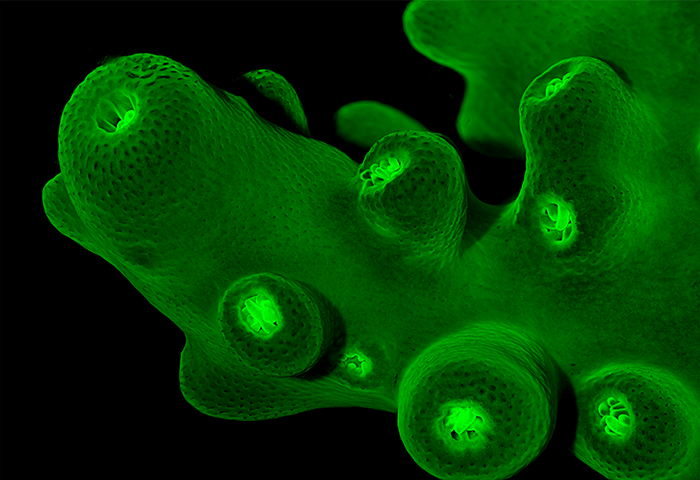
问:请与我们分享这张获奖作品背后的故事。
答:这张照片是将新颖的成像技术发挥到极致的尝试。我已经观察到一些珊瑚虫的漂亮图像,但我觉得有机会制作更详细的图像——而且我想找点乐子!
此图像是个体珊瑚息肉(1-3 毫米),位于珊瑚群的互锁组织中。我使用四个具有非常特定颜色的扫描激光对息肉进行成像。
我花了大约36小时拍摄,将70到100张图像堆叠在一起(z 堆叠),并且以3维形式呈现。每张图像需要20到30分钟来制作。
通过对珊瑚的自发荧光进行成像,我们可以识别组织的荧光发射特征,并观察这些过程在何时何地发生变化,包括单个细胞。这些变化可以绘制成图表,以便在整段时间与不同珊瑚物种之间进行比较,从而有助于确定一个群体何时健康,何时可能处于压力之下或经历变化。
粉色/橙色细胞是珊瑚的光合作用虫黄藻;生活在珊瑚组织内并为珊瑚群提供大量营养的藻类细胞。
息肉触手的球状末端充满了刺细胞,用于捕获和麻痹猎物(红色圆圈、黑色空隙和紫色)。青色主要来自珊瑚的简单支持细胞和产生粘液的细胞。
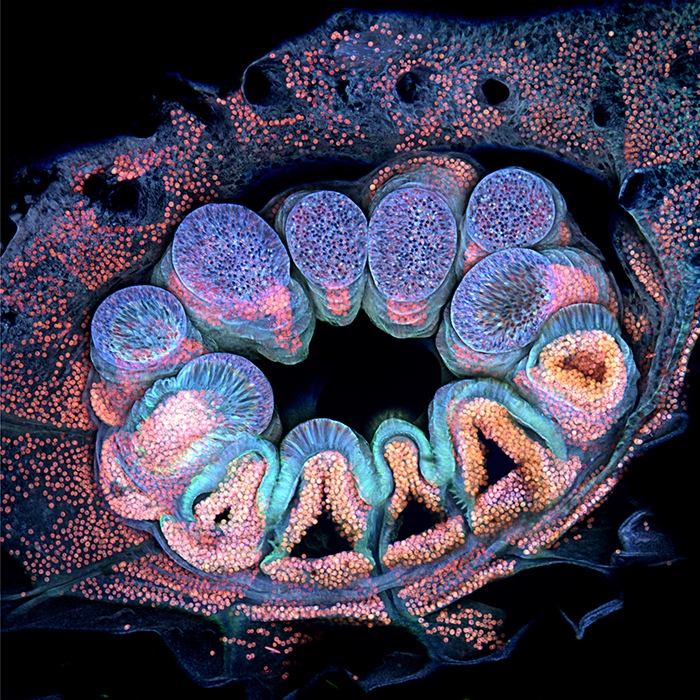
问:珊瑚群在那些方面最让你著迷?我们的地球上有多少种珊瑚?
答:地球上大约有600多种珊瑚物种。但谁知道宇宙其他地方是否还有类似珊瑚的生物。它们是一种简单的有机体,其谱系出现在大约2.5亿年前的古生代。如果宇宙其他地方存在多细胞海洋生物,它可能会看起来像珊瑚。
让我著迷的是……珊瑚是高效的猎手,尽管大多数珊瑚不能移动。
珊瑚虫的触须上有刺细胞,可以捕获猎物并将其拖入嘴里,你可以在这张图片中看到。 嘴里是胃,但在胃里是长长的消化细丝,包围并吞噬猎物。消化丝可以通过组织延伸到珊瑚体外,以抵御竞争对手和其他珊瑚群落。
现在想象一下,如果珊瑚虫更大,那将是一个更可怕的沙拉克(Sarlacc)坑。
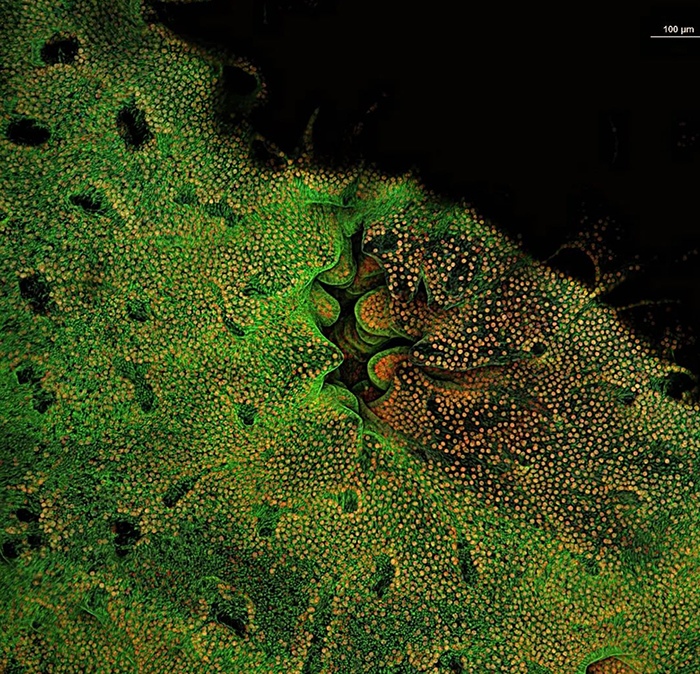
问:在你看来,珊瑚礁白化事件有多严重?目前有针对此事件的解决方案吗?
答:珊瑚礁漂白是一个巨大的问题,但它只是一种症状,一种疾病,一种珊瑚与其共生藻类(虫黄藻)关系的破裂。当藻类开始氧化时,它会在珊瑚中形成一个有毒的反馈回路。珊瑚必须排出为珊瑚提供大部分能量的藻类,以去除毒性。如果外在环境迅速恢复正常,有时珊瑚会恢复。然而,随著气候的变化,高温时期变得越来越长,珊瑚恢复的时间则变得越来越短。因此,除非我们遏制排放,否则白化和珊瑚礁的死亡将会恶化,而遏制排放的唯一方法就是保持知情,向政客施加压力并投票支持变革。
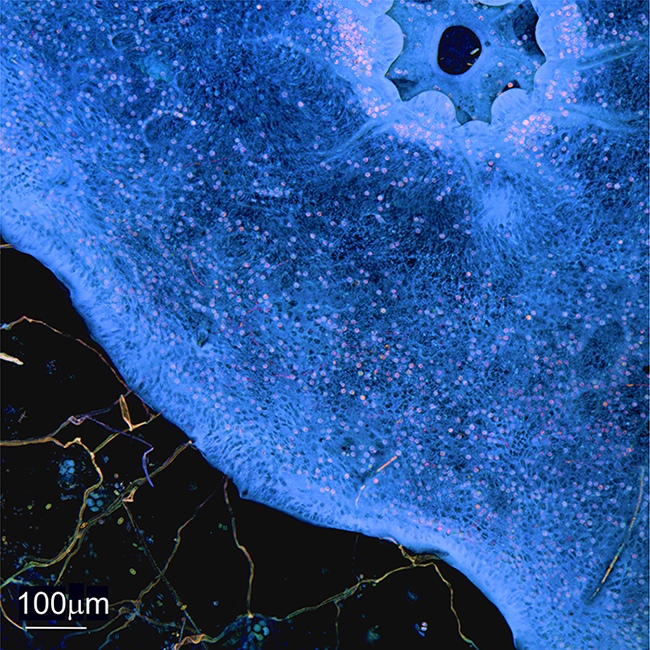
问:你使用什么设备和技术来拍摄如此清晰的海洋生物图像?
答:珊瑚经过固定、脱水、生物波处理并放入专门的成像树脂中。树脂被切割和抛光以暴露成像表面。每个样品最多需要3周的过程。
我使用Nikon A1R倒置共焦激光扫描显微镜对表面进行成像。使用的激光带宽为360nm(蓝色)、488nm(绿色)、546nm(红色)和 655(近红外),持续时间为20 到30分钟。
从大堡礁采集珊瑚并运送到昆士兰科技大学 (QUT) 的研究中心后,珊瑚会被安置在研究水族馆中。
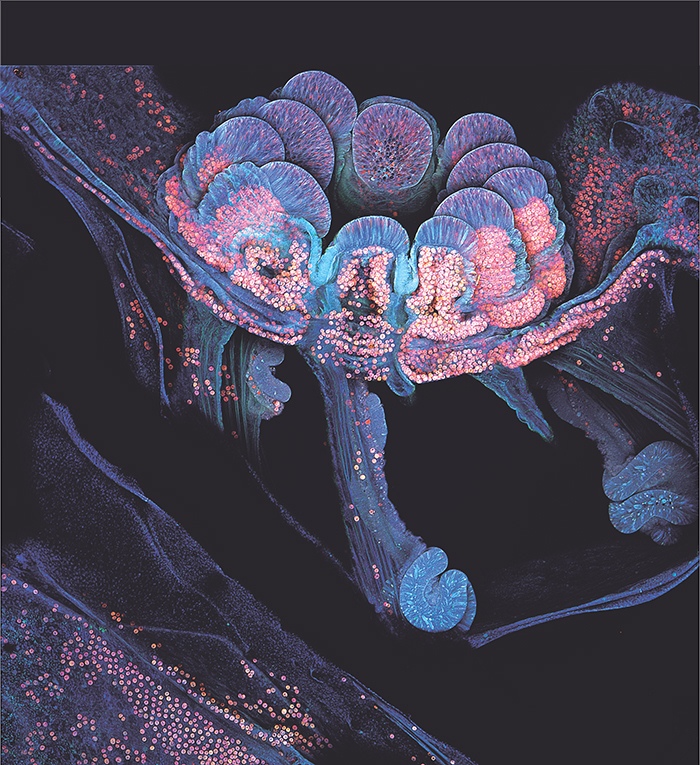
问:你还与博物馆合作为他们做装置艺术展览。请告诉我们更多关于这项工作的信息,并给我们一些你的成就例子。
答:在过去的4年里,我们的作品出现在30多个国家和国际博物馆和水族馆中。
目前,我们在昆士兰科技大学艺术博物馆举办了一场展览,作为与日本艺术家Julia和Ken Yonetani合作的一部分,我们使用AR让珊瑚栩栩如生。
我们制做的媒体已被包含在13部独立的纪录片中,包括在Netflix获奖的纪录片Reef Rescue。
我还是专注于珊瑚礁研究的澳大利亚珊瑚礁协会 (ACRS) 的委员。
为了庆祝珊瑚礁科学100周年,我们ACRS在昆士兰博物馆整理了一本咖啡桌书和博物馆展览,记录了澳大利亚珊瑚礁科学的丰富历史。
问:关于帮助珊瑚礁,你对公众有什么建议?
答:听取专家的意见,批评并投票支持有助于遏制排放的政治家和政策。

*****
我们感谢布雷特分享他的获奖图像和他对珊瑚的研究。期许他的宣导能激励更多人来保护珊瑚礁。
布雷特的Instagram